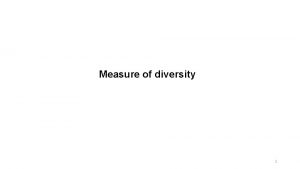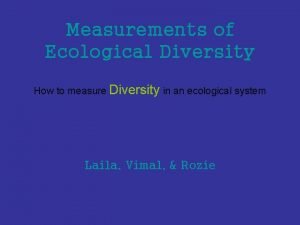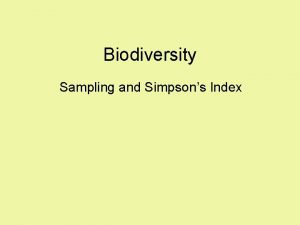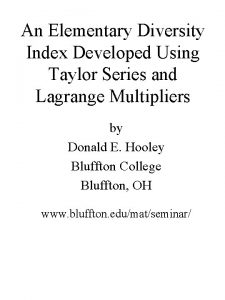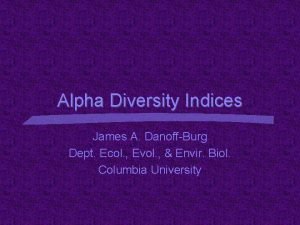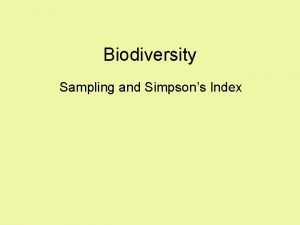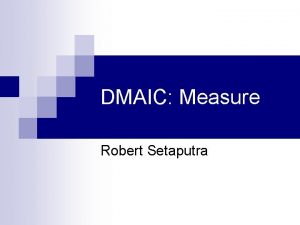Simpsons Diversity Index To measure the diversity in












- Slides: 12

Simpson’s Diversity Index To measure the diversity in an ecosystem

Simpson’s Diversity Index �Attempts to quantify the diversity (variety) of an ecosystem. �There are two components: Evenness Richness

Evenness �Evenness is a measure of the relative abundance of the different species within an area. �When the numbers of each type of species is even, the value for the Simpson Diversity Index will be larger.

Species richness �Richness is a measure of the variety of the species �More species is “richer” so the value for the index will be higher.

The equation D = N(N - 1) n(n -1) D = diversity index N = total number of organisms of all species found n = number of individuals of a particular species

The Simpson Diversity Index �A high value of D suggests a stable and ancient site �A low value of D could suggest pollution, recent colonization or agricultural management. � The value of D indicates the richness and evenness of the species found within the area sampled.

Predict the value for D for the following: (high or low) �Tropical rainforest �Desert �A wheat field �A polluted river �A tall grass prairie

How to Calculate D: D = N(N – 1) n(n -1) 1. 2. 3. 4. Record the numbers of each species Calculate n-1 for each species Find the total number of organisms, N Calculate the Simpson Diversity Index

Values for D �What is the lowest possible value? �What does a higher value indicate?

The values for D �The lowest possible value is 1. When there is only one kind of species. �This is a monoculture or an area that has been disturbed by pollution, a flood, or another big event �A high value for D indicates stability, complexity and an older ecosystem.

Calculate the Simpson’s Diversity Index for each sample Comment on the evenness and richness of each sample.

Answers �Sample One: 2. 99 �Sample Two: 1. 15 �Both have the same richness as there are three species in each area. �Sample One is more diverse because the species are more even.
 Simpsons index
Simpsons index Shannon wiener diversity index
Shannon wiener diversity index Barometer
Barometer Gibbons jacobean city comedy download
Gibbons jacobean city comedy download Alpha beta gamma diversity
Alpha beta gamma diversity What is ecosystem biodiversity
What is ecosystem biodiversity Genetic diversity vs species diversity
Genetic diversity vs species diversity Simpson's diversity index formula
Simpson's diversity index formula Simpson's diversity index formula
Simpson's diversity index formula Elementary taylor series
Elementary taylor series Biodiversity
Biodiversity Alpha diversity index
Alpha diversity index Simpson's diversity index formula
Simpson's diversity index formula

